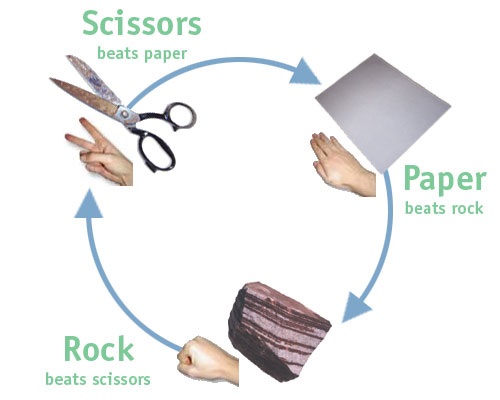
If you’ve ever attended a retreat with icebreakers, you might have enjoyed a game of Rock, Paper, Scissors which is a hand game usually played between two people. At the count of three, the players simultaneously form one of three possible shapes with an outstretched hand. Each shape represents either a “rock,” “paper,” or “scissors.”
It might seem like a silly competitive game — two people trying to outsmart the other by guessing which hand position they will present — but Rock, Paper, Scissors is based on game theory and it brings out the competitive edge in players.
Even in this game, I’ve found many women don’t like to compete. I believe it’s because if they win, someone will lose, and women don’t like to create losers. Research confirms that conventional sex role socialization can lead women to hold back, compromise early, and in the case of speechmaking, present a lukewarm presentation to avoid possibly offending someone. But increasing numbers of women today are willing to push boundaries, challenge expectations, step up, and speak up. To do this, they need to force themselves to embrace a more competitive edge.
Women don’t necessarily want to be seen as “the smartest guys in the room,” but they do need to be smart about how they present themselves if they’re going to advance their proposals. Like the game of Rock, Paper, Scissors, there are rules speakers can follow to be effective when preparing their remarks.
PSYCH OUT YOUR LISTENERS
Preparation is the key to success. Savvy speakers do their homework. They learn about who is facing them and predict what the audience is thinking, wanting, and worrying about in their daily lives. Outsmart and surprise your audience not only by the interesting way you present your position, but by also respecting differences of opinion. If you come to the podium having researched your audience, you’ll be more effective in gaining and holding their attention. When preparing your next presentation, consider three strategies you can adapt from Rock, Paper, Scissors:
 ROCK APPROACH:
ROCK APPROACH:
Are you tough minded about your position? Are you hard-nosed about your point of view? If you are, you might be too confident and disrespect the point of view your listeners. Do you dismiss them as “the deplorables,” the uneducated masses, the unwashed, or those who care only about themselves? I believe we can learn the most from people who are the most different from us. You can’t know everything about your subject. Maybe they have a story to tell that will enlighten you. Audiences want to feel the speaker has empathy for their unique experience and issues.
ROCK STRATEGY:
- Drill down into why the listeners feel the way they do. Make sure you understand their values, wants, and needs before you present your key proposal. Otherwise, they may find you dismissive and lacking in empathy.
- Understand what they prize and cherish. How will your proposal respect their values?
- Highlight what they lose (and gain) if they support your innovative proposal.
The audience might “push back” and resist your ideas for change. Using the Rock approach, you’ll be ready to grab their attention and address their concerns directly.
 PAPER APPROACH:
PAPER APPROACH:
You know from business or college that a “paper” is an authoritative report that informs readers concisely about a complex issue or idea. While your remarks should be designed to help readers understand an issue, solve a problem, or make a decision, you’re communicating your position orally. Listeners can’t use a yellow highlighter to remind them of your main points as they would while reading a technical paper.
You can’t sound as if you’re reading a paper. Your voice needs to be lively, varying pitch, volume, and pacing. You need to make your points in a conversational tone that will make the listeners feel that your ideas are just occurring to you. You need to dramatize some of your points, particularly when you’re reporting on statistics or hard data.
Statistics are just numbers on a page unless the speakers makes the information come alive. For example, 17 students were killed at Parkland School in one of the deadliest school shootings in modern American history. You’ll want to dramatize these types of statistics in ways that will grab your audience and leave them breathless. You might say:
Alyssa, 14, a soccer player for Parkland Travel Soccer and red-haired Cara Loughran, 14, a performer with the Drake School of Irish Dance, were both shot and killed yesterday during the Parkland School tragedy. Geography teacher Scott Beigel was also killed as he ushered students back into his classroom. And assistant football coach Aaron Feis threw himself in front of students to protect them from oncoming bullets.
Some words that lie dead upon the page sound beautiful when spoken aloud. Words like evocative, harbinger, serendipity, mellifluous, effusive, and plethora can add texture to your speech.
Paper is a flexible medium for creating artworks. It can include twisted curves of nature or complicated geometrical shapes. It can wrap around something – like a rock – and conceal it. It can be lightweight or heavyweight. Using the Paper approach, your remarks can lighten up a dark subject or convey the seriousness of a topic we’d rather ignore.
PAPER STRATEGY:
- Study the topic from multiple viewpoints so that you are seen as flexible.
- Consider the tone of your remarks. Find exciting ways to appeal to all five senses. Are you going to be smooth or will your presentation be blunt, rough-and-tough?
- Find funny headlines on Google or a comedic sketch on YouTube to convey the absurdity of the non-stop demands we experience every day.
- Wrap your mind around hard data and be able to translate it to a layperson’s language. Use real people to make important but confusing statistics come alive.
Using a Paper approach, you will be engaging an audience by embracing data in a fresh way that is engaging.
 SCISSORS APPROACH:
SCISSORS APPROACH:
This approach is direct and blunt, cutting through red tape and challenging assumptions that are biased. Sure, everyone has a bias and the truth can be evasive, but if you assert your case by balancing well-respected research with diverse “person-on-the-street” interviews, you’ll get closer to what is really going on. Intelligent people can handle information that wakes them up and forces them to shift their position.
Audiences today are hungry to hear a fresh take on an emerging issue or even on an age-old problem that has seemed insurmountable. For instance, besides “death and taxes,” consider these issues that are polarizing the country: gun control, abortion, fracking, climate change, immigration, school vouchers, healthcare, addiction and homelessness. If you’re establishing leadership, you will want to take a problem apart and reframe the situation with a solution that will benefit everyone.
Any change will seem overwhelming at first. You don’t want to slice-and-dice the problem in ways that reflect typical complaints. Rather, focus on just a few aspects of the problem. Cut through your audience’s resistance to changing their ways of thinking and acting.
SCISSORS STRATEGY:
- Identify the specific obstacles that are standing in the way of a change you’ve identified as beneficial. Think about clever ways to expedite change and how to cut through red tape.
- Flaunt your research. Quote people your listeners respect.
- Propose small baby steps to make progress toward a better solution.
Using a Scissors approach, you will help your audience address an issue by cutting it down to a manageable size.
SPEAKING IS LEADING
In conclusion, leaders are people who can communicate the fact that they are exceptional. Leaders are ahead of the curve. They see around the bend. They have the mile-high view most others lack. The have strategies for success to sell to their listeners. Setting oneself apart from the group isn’t a comfortable position for many women who don’t want to be seen as “bossy” or self-aggrandizing; however, at the podium, you are the boss. All eyes are on you, waiting to hear what you have to say. Just like the game Rock, Paper, Scissors, there are (at least) two other positions that can contradict yours. You’ll know you’ve “won” if the listeners endorse your proposal, invest in your company, vote for you, or buy what you’re selling. Those are examples of the victories possible from preparing your remarks in a strategic way.
[1] https://en.wikipedia.org/wiki/Rock–paper–scissors
“rock crushes scissors” or sometimes “blunts scissors”[1]), but will lose to one who has played paper (“paper covers rock”); a play of paper will lose to a play of scissors (“scissors cuts paper”). If both players choose the same shape, the game is tied and is usually immediately replayed to break the tie.
[2] https://justenglish.me/2015/03/23/the-100-most-beautiful-words-in-english/